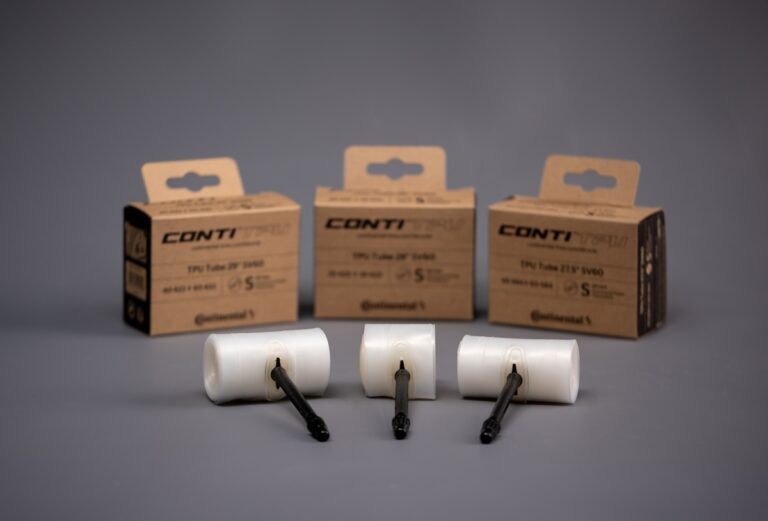

Written by Lars Hundley
Continental launches ContiTPU, a German-made TPU inner tube designed for road, gravel and mountain bike riders. The ContiTPU inner tube is a new addition to Continental’s product range, giving cyclists a new lightweight and durable tube option for their rides.
ContiTPU inner tubes are constructed using seven sealed layers of high-grade, micrometer-thick thermoplastic polyurethane (TPU). This multi-layer design ensures maximum tightness and durability, making it suitable for both on- and off-road cycling. The tubes are not colored to maintain the highest material quality and prevent air retention issues that can be caused by dye-related surface imperfections.
One of the key features of the ContiTPU inner tube is its lightweight construction. The 700c x 25-35mm size weighs only 35 grams, while the 700c x 40-60mm and 650B/27.5 inch x 40-60mm sizes weigh 45 grams and 43 grams respectively. This lightweight design, combined with the tube’s low rolling resistance, makes it an attractive option for performance-minded cyclists looking to save weight and increase riding efficiency.
The ContiTPU inner tube also has a small pack size, allowing cyclists to easily carry a spare tube on long rides without sacrificing storage space. Each pack includes repair patches for easy fixes on the go.
Continental designed the valve base to be slightly conical, improving the fit on the wheel rim and reducing unwanted movement. The valve has internal threads, allowing for the use of valve extensions or replacement valve cores if required.
TPU tubes should never be used with rim brakes, as exposure to excessive heat can lead to sudden loss of air pressure. A cyclist should also protect his TPU tube from damage by using appropriate rim tape and ensure that the valve holes in the rim are the correct diameter to prevent twisting or shearing of the valve. When installing the tube, do not inflate it more than 4 psi until it is completely seated inside the tire and on the rim. Inflating too much air during this process can cause the tube to overstretch and become unusable. Finally, don’t reuse TPU tubes in smaller tires. If you are installing a smaller tire, you will need to use a new tube.
TPU tube, what is the difference? Overview of tube types
- TPU tube: TPU tube made from thermoplastic polyurethane is the lightest of the three types. It is more compact and has better puncture resistance than butyl tubes. TPU tubing is easy to repair and has low rolling resistance, increasing running efficiency. However, it is generally more expensive than butyl tubing.
- butyl tube: The most common type of bicycle tube, made from synthetic rubber. It is relatively inexpensive, durable, and has excellent air retention properties. However, it is heavier than TPU or latex tubing.
- latex tube: Latex tubing is lighter than butyl tubing, but slightly heavier than TPU tubing. It has low rolling resistance and is often preferred by professional and competitive cyclists. However, latex tubing has a shorter lifespan than butyl he tubes or he TPU tubes, requires more frequent inflation, and is more prone to punctures.
Continental’s entry into the TPU tube market signifies the growing popularity and demand for TPU tubes among cyclists. Brands such as Pirelli and Tuvolito have already introduced their own TPU tube products, known for their lightweight, durability and compact design. One of the notable things about Continental’s ContiTPU tubes is that they are manufactured entirely in Germany, including the sourcing of raw materials. This focus on local production sets Continental apart from some competitors and may appeal to cyclists who value European-made products.
ContiTPU inner tubes are available in a wide range of sizes, including options for 700c (ISO 622) and 650B/27.5 inch (ISO 584) wheels commonly used on road, gravel and mountain bikes. Combining lightweight construction, durability, and a small pack size, ContiTPU inner tubes are an excellent choice for cyclists of all disciplines looking for optimized ride quality.
Next article: Question of the week

